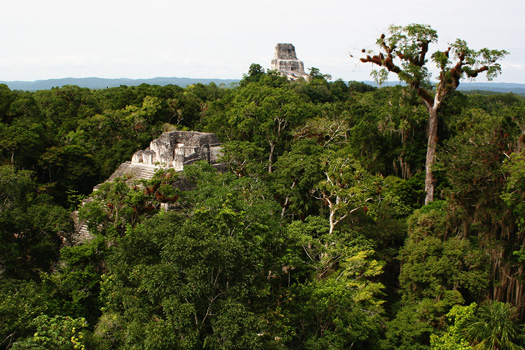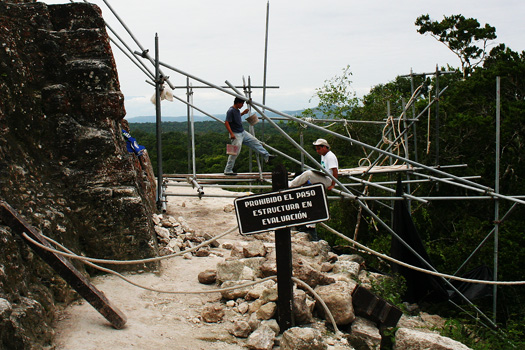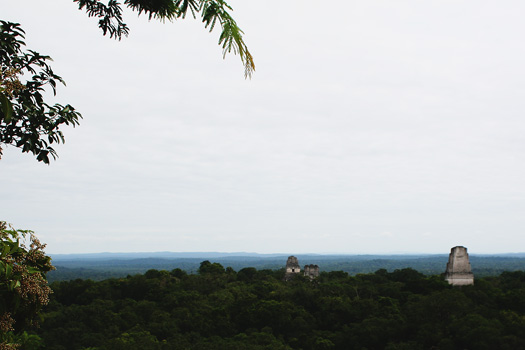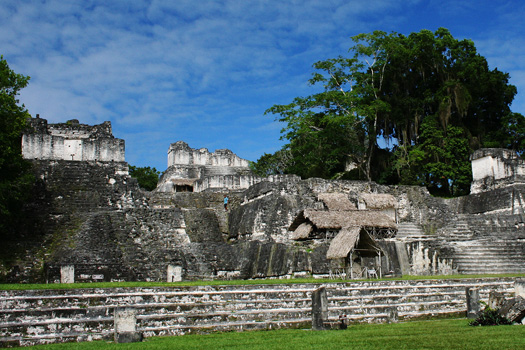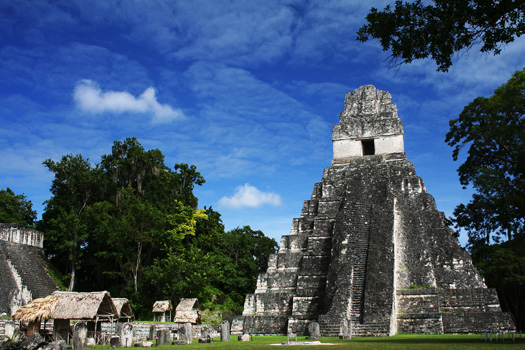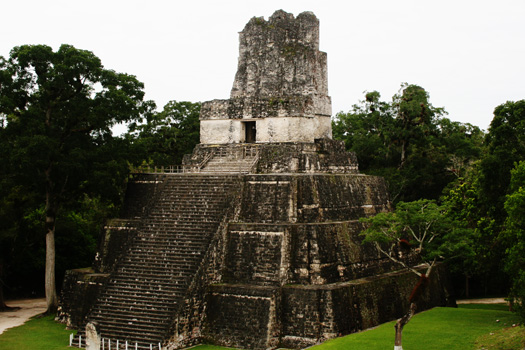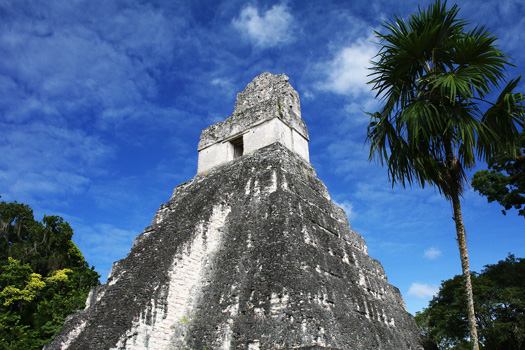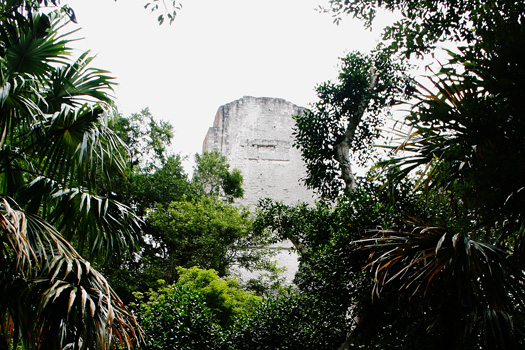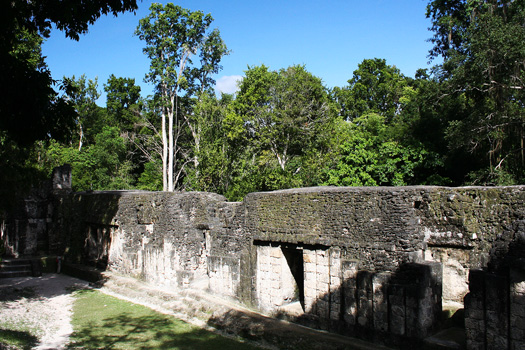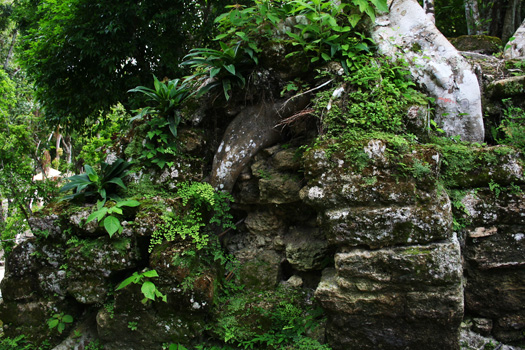2006 AD: The Maya ruins of Tikal, Guatemala
For about 400 years was nothing more than a tiny farming village on high ground surrounded by swamps in the rain forest of Petén. In 500 BC however the very first limestone structure was built, a small temple to enhance astronomical observations to determine the best time for crop planting and harvesting. Some 300 years later this temple at the Mundo Perdido ('Lost World') site was enlarged to form a pyramid and smaller temples were erected in the Acropolis Norte. The irreversible decline of the ancient Snake Kingdom of El Mirador, one of the early Maya superpowers, around 150 AD saw Tikal increase in size and importance. Its position on a major overland trade route established long-distance commercial and political alliances such as with Teotihuacán some 900 kilometres west. Apart from strengthening Tikal's economical position, it also brought Tikal in contact with other ideologies and religions, technologies, arts and architecture.
It was this relationship with Teotihuacán what proved to be crucial and vital in the ensuing rivalry with Uaxactún, just 20 kilometres to the north. When in 378 AD animosity reached crisis point and threatened to disrupt trade operations King Atlatl Cauac ('Spearthrower Owl') of Teotihuacán dispatched his general Siyah K'ak ('Fire-is-Born') to restore order. What happened next is shrouded in the mist of time but the outcome was not only that Uaxactún was overran by Siyah's forces and perhaps Tikal's warriors but also that he might have ordered the execution of Jaguar Paw, the King of Tikal. In his place King Atlatl installed his young son Yax Nuun Ayiin I ('Crocodile I') as the new King of Tikal under regency of Siyah. More importantly, Tikal now usurped Uaxactún in power and significance and continued to dominate the central Petén region for the next couple of centuries, even when Teotihuacán's political influence slowly began to wane. The trade in high valuable commodities (e.g. cacao from the Caribbean coast) with neighbouring cities such as Río Azul brought Tikal more wealth. It also was a guarentee for political might as evident by the installment of one of Tikal's own royalty on the throne of Río Azul, which had become its most northern outpost and thereby closest to an ever emerging threat.
It was the reincarnation of the Snake Kingdom this time under the name of Calakmul that spelled trouble. Just 100 kilometres to the north, it became extremely powerful through political alliances, whether forced or not, and its territory slowly started to encroach into that of Tikal. Calakmul's King Tuun K'ab' Hix ('Stone hand Jaguar') overran Río Azul in 530 and through royal marriage it took control over small but strategically situated cities such as Waká (also called El Perú), less than 80 km from Tikal and Naranjo virtually on its adversary's doorstep. Then news broke that Calakmul was in negotiation with the sizable city of Caracol (in modern day Belize) to join the alliance, a move which could see Tikal encircled by hostile powers aligned with Calakmul (see map below). A struggle for supremacy was clearly inevitable and the resulting conflict soon escalated into full blown 'star wars'.
Please browse to http://www.skylla.co.uk
if the map does not appear in a few seconds.
In 556 Tikal's King Wak Chan K'awil ('Double Bird') opted for a pre-emptive strike against King Yahaw Te ('Water Lord') of Caracol, destroying part of the city and ritually sacrificing some of its nobility. Six years later however Caracol hit back with support from Calakmul in a devastating assault on Tikal, killing its King and nearly managed to wipe the city off the face of the earth. Decades later further humiliation was brought, but this time by one of Tikal's own. Around 630 a King of Tikal's Chan K'awil dynasty had founded the garrison outpost of Dos Pilas, just 100 km south-west of Tikal, and had installed his own loyal brother B'alaj Chan K'awil ('Lightening Sky') as its ruler. Some twenty years later however, Calakmul instigated a civil war within the Tikal Kingdom by coercing B'alaj to betray his own family and wage a campaign of terror on Tikal. After years of forceful suppression he went on to inflict a damaging blow in about 657 by taking the King and many other aristocrats captive and ritually sacrificing them in a horrific celebration of blood and gore. The renegade King then proclaimed victory and subsequently renamed Dos Pilas as New Tikal. It took Tikal decades to recover from this disgraceful defeat but under King Hasaw Chan K'awil ('Heavenly Standard Bearer') at the end of the seventh century its confidence was somewhat restored when a complete restoration begun of the city and newer buildings were commissioned. A collective age-old hatred now saw Tikal confronting its arch enemy head on and in 695 it avenged itself by invading and ransacking Calakmul. Its King Yich'aak K'ak' ('Fiery Jaguar Claw') was captured and executed and so was its successor 'Split Earth' months later. The rulers of the treacherous city of Dos Pilas soon followed the same fate. And when they finally broke the Snake's alliance by defeating Waká and Naranjo in the 740s Tikal eventually emerged as a regionwide superpower.
Published on 10.12.2006 by Sjaak van der Sar – Leave critique or other comments

